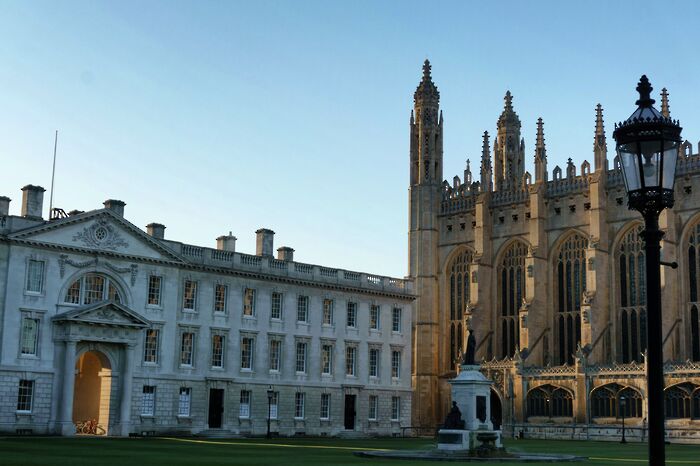Removing historic symbols threatens to obscure our past
Taking down the Soviet flag from King’s College bar serves to erase its history of communist associations, says Alexander Shtyrov

Following a vote in November, the flag on the wall of King’s College bar will no longer be red and gold. The hammer and sickle is now due to be replaced with a ‘wall of flags’, with the LGBT+ flag the first to be raised. However, in my view, removing the Soviet flag represents a muffling of King’s history, given the College’s historic ties to what that flag symbolised.
Since the Soviet flag was first placed in King’s bar in 2004 in order to deter a common act of vandalism, that of drawing the flag on the wall, it has become an iconic symbol in the college. The red rectangle, with its yellow star and hammer and sickle symbol, shows visitors to the College that King’s acknowledges its history and the stereotypes it engenders, and is not ashamed of them. The stated reason for replacing the flag is “primarily because it was considered hurtful, offensive and exclusionary to King’s members whose families suffered under Soviet rule” (with this oppression undoubtedly a feature of life in the USSR that can only be condemned).
One outcome of this change is to stop reminding bar-goers of the Soviet associations that played such a key role in King’s history. Whatever your attitude to the USSR, it is hard to deny that one of the College’s best-publicised marks on 20th century history was made through characters such as Soviet spies Kim Philby, Guy Burgess, and Anthony Blunt, who held their meetings there, and celebrated history professor and ‘unrepentant Stalinist’ Eric Hobsbawm. KCSU’s decision risks obscuring this history.
“Place names, statues, and symbols in public places have a potent influence upon the public mind”
While the recent KCSU debates are not exactly events of historical magnitude, they do mirror similar policies being enacted, albeit on the scale of entire states, in countries formerly belonging to the Eastern bloc; the Polish government has been dismantling Soviet monuments for over a decade now, while communist symbols have been banned in Ukraine since a law passed in 2015 outlawed them. The debate on how to deal with uncomfortable or ideologically inconvenient history is not restricted to the symbols of communist regimes or to eastern Europe however. In the United States, the monuments being dismantled were erected in honour of slave owners, and those defending them hail from the right, not the left.
Sometimes, when monuments are embodiments of hate of an ethnic or social group, the dustbin is the best place for them. I do not therefore condemn the post-war Germany for its taking down of swastikas, as Nazism is legally recognised around the world as an abhorrent ideology. Yet in the majority of cases facing us today, the decision about whether to dismantle or not to dismantle is somewhat subjective, made based on whatever dogma is currently in fashion (and in power).
The erroneous mindset of the dismantlers is that we, as a society, are on the march from a time that is bad (however you define that), to one that is somehow good, and that any reminders of this bad past should be consigned to the dustbin of history.
“The constant changes in ideology apply as much in Cambridge as in more politically turbulent places”
Churchill College is named after a certain British national hero. Right now, in the throes of Brexit, when Britain needs a hero who charted a firmly independent course for his country, Churchill is in fashion. Who could not have noted the respectful and borderline laudatory treatment he was given in the recent films Darkest Hour and Churchill by Gary Oldman and Brian Cox respectively? Now, Churchill held some extremely racist views. Recently, people have become more willing to come forward and denigrate Churchill as a racist and white supremacist, such as Kehinde Andrews on Good Morning Britain. The popular consensus however, represented on this programme by Piers Morgan, prefers to assert his status as a national hero. Nonetheless, it is not difficult to imagine that perhaps in a few decades, when Churchill is a more distant historical figure, a more wholesale dismissal of Churchill will be in mode. The constant changes in ideology apply as much in Cambridge as in more politically turbulent places.
Our history defines us. In preserving monuments, we benefit the present. Because by attempting to conceal the past, we pervert our own identities, and deliberately produce a public that is less well-informed of its history, the opposite of the sort of enlightened, tolerant public required for an enlightened, tolerant 21st century. We also benefit the legacy we leave for future generations. Because if we set the precedent of destroying our ancestor’s works, why should our descendants not destroy ours?
 Features / Cambridge: where toxic productivity turns rest into a radical act8 April 2025
Features / Cambridge: where toxic productivity turns rest into a radical act8 April 2025 News / Rowing row continues as Oxford and Cambridge scrap women’s trial race9 April 2025
News / Rowing row continues as Oxford and Cambridge scrap women’s trial race9 April 2025 News / Under 3% of applicants for Cambridge academic jobs are successful7 April 2025
News / Under 3% of applicants for Cambridge academic jobs are successful7 April 2025 News / Uni to ‘review’ tripos rankings and weekend lectures in undergrad teaching overhaul10 April 2025
News / Uni to ‘review’ tripos rankings and weekend lectures in undergrad teaching overhaul10 April 2025 Comment / Death of the June Event?9 April 2025
Comment / Death of the June Event?9 April 2025





